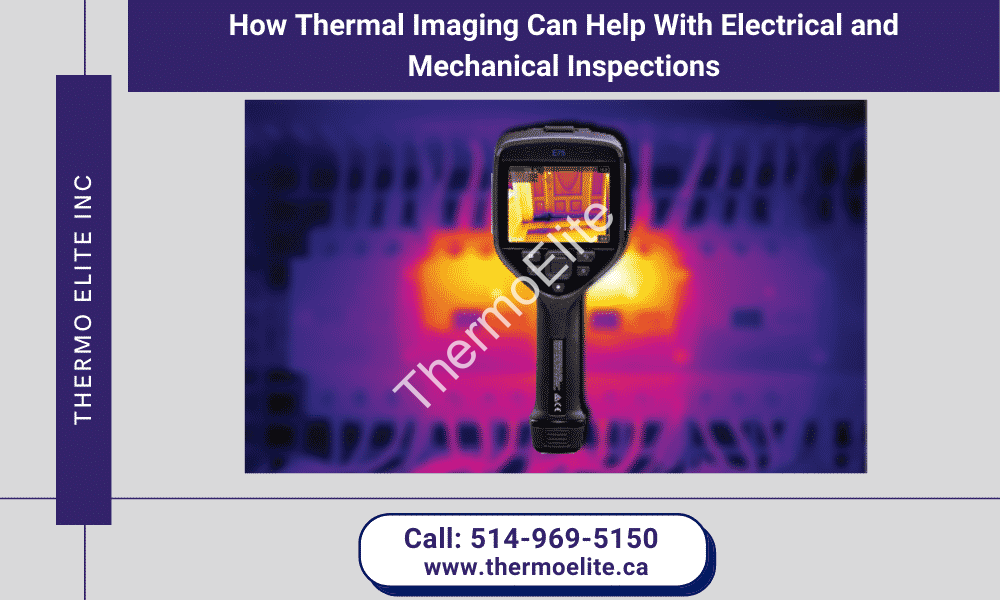Are you struggling to identify potential electrical or mechanical issues before they cause costly downtime and repairs?
Discover how thermal imaging can help you quickly and accurately detect problems and prevent equipment failures, ultimately saving you time and money.
Thermal imaging cameras are handy in several ways. Thermal imaging cameras efficiently convert heat – or thermal energy – into visible light to analyze the surroundings. As a result, they’re incredibly adaptable. Thermal devices can see living objects and mechanical equipment even in the dark because they emit heat. These cameras are exact and only need a small amount of heat to operate.
The thermography inspection tool is a method that can be used to evaluate plant conditions, preventative maintenance, and process control. Inspection of electrical equipment, mechanical equipment, and refractory lined structures are all possible applications.
How Does Thermal Imaging Work?
The current industry norm for thermal cameras is to display warmer objects with a yellow-orange hue that brightens as the item heats up. The color blue or purple is used to represent colder things.
The wavelength of infrared energy starts at about 700 nanometers and extends to around 1mm. Wavelengths that are shorter than this are visible to the naked eye. Thermal imaging cameras use infrared energy to produce thermal images. The camera’s lens directs infrared energy onto a series of detectors with a complex pattern known as a thermogram.
The level of thermal radiation emitted by an object is called its heat signature. The more radiation a given object emits into the atmosphere, the hotter it is. The thermal imager can detect heat sources as well as minute variations in thermal radiation. It compiles this information into a full “heat map” with heat levels.
What is Thermal Imaging Used For?
Since the Korean War, thermal imaging cameras have been used for scouting and fighting operations at night. They’ve been strengthened since then and are now used by firefighters, electricians, law enforcement officers, and disaster relief teams. They are also widely used in the inspection, repair, and optimization of buildings.
Today thermal inspection has been widely used in electrical and mechanical inspections.
What is Thermal Electrical Inspection?
Thermography is a method of inspecting electrical and mechanical devices by getting heat distribution pictures through the process. This inspection method is based on the fact that it raises its temperature when a machine malfunctions.
Usually, the main reason behind the electric circuit is loose connections and faulty wires. With the help of thermography, the faults can be easily located by analyzing the heat patterns in operational system components.
Thermal imaging detects faults in equipment and pinpoints any hot spots that are frequently undetectable to the naked eye. When parts of your electrical system start to malfunction, they emit heat, usually a sign of electrical resistance or excessive friction. The abnormal temperature can be easily detected and recorded.
What Are The Benefits Of Thermal Image Scanning?
Thermal imaging as a tool for early detection of equipment failure can directly help you in the following ways:
Cost savings: – Thermal scanning is the most cost-effective preventative method available. Thermal scanning will help you reduce downtime and protect your company if you take the required precautions early. It will help you detect the faults at the early stages, and you can repair them before they cause any significant harm.
Non-destructive testing:- This is a non-invasive and non-destructive technique that helps you inspect your electrical equipments without disconnecting the ongoing work or destroying any equipment. You can easily detect heat-related external anomalies using thermography. It is also effortless to see internal equipment failures with it.
Reduce fire hazards: – Usually, any fire hazards within a building are due to short circuits. If the circuit wire insulation fails, the current will flow to the neutral wire, resulting in an electrical surge and a short circuit. Fault wire and old switches are also the main reason behind it. With the help of thermography, it is easy to detect these faults before they cause any significant harm.
Early detection of any potential faults
How Often Do Switchboards & Other Electrical Equipment Need To Be Scanned?
It would help if you regularly inspected your switchboards and other electrical equipment. Usually, you can only know about your electrical system’s faults when it fails to work. Downtime can be expensive and damaging to your business.
Electrical components can burn up when they get heated. You can detect the heat increase with infrared thermal scanning and fix the growing problems early. You can fix the issue before the component fails.
Excess resistance on electrical apparatus indicates electrical faults such as:
- Loose connections
- Overloads
- Imbalanced circuits
- Faulty equipment
- Damaged switches
- Faulty fuses
- Other unwanted electrical conditions
A thermographic scan identifies issues that can be addressed during planned maintenance periods and downtime. This allows your system to run at optimum performance, enhancing the company’s reliability and cost-effectiveness.
Infrared Thermography for Mechanical Applications
The process of using a thermal imager to detect infrared radiation (heat) emitted by an object is known as infrared thermography. Operators may use the technology to verify normal operations and, more importantly, detect thermal anomalies (abnormal patterns of heat that are invisible to the naked eye) that signify potential flaws, defects, or inefficiencies in a system machine.
Infrared thermography inspections of mechanical equipment include a broad range of systems, including engines, rotating equipment, steam traps, refractory, and tank levels. While there are many ways to find electrical and mechanical machines’ problems, thermography has been very useful, mainly as a quick and efficient screening tool. Being a non-destructive technique, you can easily detect the faults without damaging the parts. Thermal imaging captures the excess heat by excessive friction, high electrical resistance, reduced cooling air or fluids, and problems with current flow in a motor.
It can easily catch the problem in the form of abnormal thermal signatures seen in the infrared image. There are also other methods like vibration study, motor circuit analysis, etc., to know precisely what is causing an anomaly.
A detectable vibration signature could be preceded by abnormal heating, such as that which occurs in a misaligned coupling. If left unaddressed, a problem like this can worsen or even cause the motor bearing to wear out. This is usually detectable using thermography. The total temperature of the motor, including the motor housing, will rise due to an internal fault caused by the breakdown of insulation on the motor windings. When the cooling airflow pathways in a motor become blocked, the winding insulation often fails as well.
Another use for infrared thermography is bearing inspection. The temperature of a bearing’s surface rises as abnormal friction inside the bearing generates heat. When this thermal signature is detected, it indicates a possible bearing problem, which may be anything from under-lubrication to over-lubrication, low maintenance, or merely a bad bearing. Infrared is particularly useful for rapidly and easily inspecting low-speed machineries, such as overhead conveyors or idlers.
Temperatures on high-temperature refractory insulation, such as a spinning kiln, furnace, or boiler, are monitored using thermography. In these situations, thermal patterns may be used to monitor the insulation’s condition or even determine the thickness of the remaining refractory.
Conclusion
In conclusion, electrical and mechanical infrared inspections can be both financially and professionally challenging and rewarding. The person conducting the inspection must have a good understanding of the equipment they’re looking at and enough heat transfer theory information to interpret the thermal patterns they see.



Add Comment